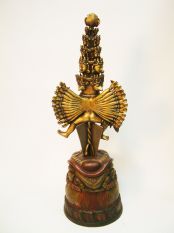Detailed Description of the Ritual Tool "Phurba" in Tibetan Buddhism:Name and Form:Also Known as "Triple Dagger": Phurba, also referred to as the "Triple Dagger" in Tibetan Buddhism, is a distinctive ritual tool.
Its name derives from the Sanskrit "Kila" or "Phurba," meaning "nail" or "to fasten."Three-Sided Blade: Phurba typically features a central handle and terminates in a three-sided blade, representing wisdom, method, and result. These three facets symbolize the power to transcend the three poisons (greed, hatred, and delusion)
Symbolic Significance:Purification of Obstacles: The use of Phurba is associated with purification, dispelling evil spirits, and overcoming obstacles. In spiritual practice, it is seen as a tool to sever ignorance, enabling individuals to transcend difficulties and hindrances.Nailing Down Malevolent Forces: Phurba is believed to "nail down" malevolent spirits or malicious forces, preventing them from causing harm to individuals or communities.Purpose and Rituals:Spiritual Ceremonies: Phurba is commonly employed in spiritual ceremonies, particularly those with protective and purifying qualities. Monks or practitioners may use Phurba in rituals to ensure the smooth fruition of blessings and aspirations.Overcoming Obstacles: In some rituals, Phurba is used symbolically to "subdue" or transcend obstacles and hindrances.Materials of Construction:Metal and Gemstones: Phurba is crafted from metals and may be adorned with various gemstones.
These gemstones symbolize the sacredness and power of the ritual tool.Profound Symbolism:Transcendence of the Three Realms: The three-sided blade symbolizes transcending the three realms of existence—birth, death, and the intermediate state. It underscores the transcendent nature of the ritual tool and its relevance to individual spiritual progress.In summary,
Phurba in Tibetan Buddhism is a ritual tool with profound symbolic significance, involving aspects of purification, protection, and the transcendence of obstacles.

|